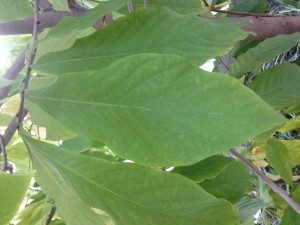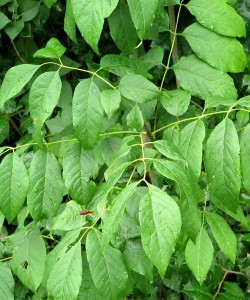A plant with obovate leaves
Obovate leaves definition- leaves that are wider near the tip or apex of the leaf.
Asimina Triloba (pawpaw)
Description- alternate leaves, large obovate leaves, entire margins, pinnate venation, glabrous, prefers moist environments, green edible fruits.
Found behind Jennings Hall.
A plant with actinomorphic flowers
Actinomorphic flower definition- a flower that has radial symmetry. Can be divided into identical sections along any plane.
Hemerocallis lilioasphodelus (yellow daylily)
Description- trumpet shaped yellow flowers with radial symmetry, long arching leaves, superior ovary, fruit are capsules, 6-merous.
Found outside of apartment buildings along 12th street.
Toxicodendron radicans (poison ivy)
First identified because of characteristic 3 compound leaves with middle leaf extending on long petiole. I also noticed it because it had begun changing colors, which is common for poison ivy to do early in the fall. Other characteristics of poison ivy are that it is a woody vine and can have variable leaf margins but are many times toothed or lobed.
Found at Alum Creek park.
Fraxinus spp.
Fraxinus pennsylvanica (green ash)
Determined to be an ash because of the compound, opposite leaves. Also the distinctive brown buds that sit on top of a “D” shaped leaf scar. I decided that it was a green ash verses other varieties because the bud sat on top of the leaf scar, unlike white ash that have buds sitting down in a “C” shaped scar. I also found the seedling in a wet-mesic are, a preferred site for green ash. I was unable to find any plants bigger than this due to emerald ash borer killing almost all of the larger trees in our area.
Found at Alum Creek park.
A member of the Lamiaceae with an explanation of the characters that you used to determine the family identification
Species unknown
The characteristics I used to determine that this plant was in the mint family was first of all the most obvious, the aroma. Next, I felt the stem and confirmed that it was square. I also noticed that the leaves were opposite and serrate. And finally, I felt that the plant was pubescent. All of which are common characteristics for the family.
Found behind Jennings Hall.
A member of the Poaceae with an explanation of the characters that you used to determine the family identification
Bambuseae
Bamboo is not what would typically come to mind right away when thinking about the grass family. It is, however, a member. Typical family characteristics that I found that it possesses are alternate leaves, tubular sheathing leaves with blades at nodes, and ligules or thin membranes where blades are attached.
Found in my backyard.







That’s so interesting that you found bamboo, even to find it in your backyard! I didn’t know they were part of the grass family. The leaves look lanceolate with entire margins.
Thats a fine Ash you found. Are there any paw paw fruit on the tree you found? Great pictures.
I appreciate the fact that you posted a picture of the Poison Ivy after it had turned red. I did not know that it changed color before dying for the year. The picture clearly shows the three defining leaves, two opposite of one another with the third extending on a long petiole. Great find, thanks for sharing!